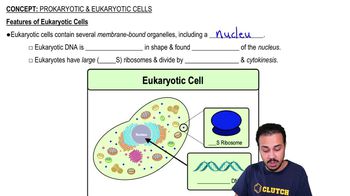According to the fluid mosaic model of membrane structure, proteins of the membrane are mostly a. spread in a continuous layer over the inner and outer surfaces of the membrane. b. confined to the hydrophobic interior of the membrane. c. embedded in a lipid bilayer. d. randomly oriented in the membrane, with no fixed inside-outside polarity.
Ch. 7 - Membrane Structure and Function
Chapter 7, Problem 1
In what way do the membranes of a eukaryotic cell vary? a. Phospholipids are found only in certain membranes. b. Certain proteins are unique to each membrane. c. Only certain membranes of the cell are selectively permeable. d. Only certain membranes are constructed from amphipathic molecules.

Verified Solution
Video duration:
41sWas this helpful?
Key Concepts
Here are the essential concepts you must grasp in order to answer the question correctly.
Eukaryotic Cell Membranes
Eukaryotic cells have complex membranes that serve as barriers and facilitators for cellular processes. These membranes are primarily composed of a phospholipid bilayer, which provides fluidity and flexibility, allowing for the compartmentalization of cellular functions. Each membrane can have distinct compositions and functions, reflecting the specific roles of the organelles they enclose.
Recommended video:
Guided course

Features of Eukaryotic Cells
Membrane Proteins
Membrane proteins are integral or peripheral proteins that perform various functions, including transport, signaling, and structural support. Different membranes can contain unique sets of proteins, which contribute to the specific functions of each membrane. For example, the proteins in the plasma membrane differ from those in the endoplasmic reticulum, reflecting their distinct roles in the cell.
Recommended video:
Guided course

Types of Membrane Proteins
Selective Permeability
Selective permeability refers to the ability of a membrane to allow certain substances to pass while blocking others. This property is crucial for maintaining homeostasis within the cell, as it regulates the entry and exit of ions, nutrients, and waste products. Not all membranes exhibit the same level of selective permeability, which can vary based on their composition and the presence of specific transport proteins.
Recommended video:

Natural Selection
Related Practice
Textbook Question
2850
views
Textbook Question
Which of the following factors would tend to increase membrane fluidity? a. a greater proportion of unsaturated phospholipids b. a greater proportion of saturated phospholipids c. a lower temperature d. a relatively high protein content in the membrane
2144
views
Textbook Question
Which of the following processes includes all the others? a. osmosis b. diffusion of a solute across a membrane c. passive transport d. transport of an ion down its electrochemical gradient
1329
views
